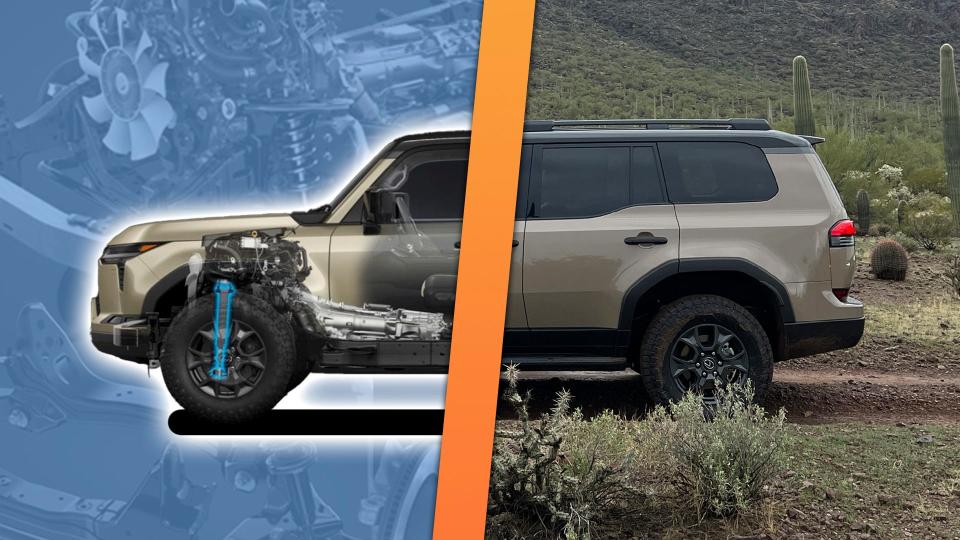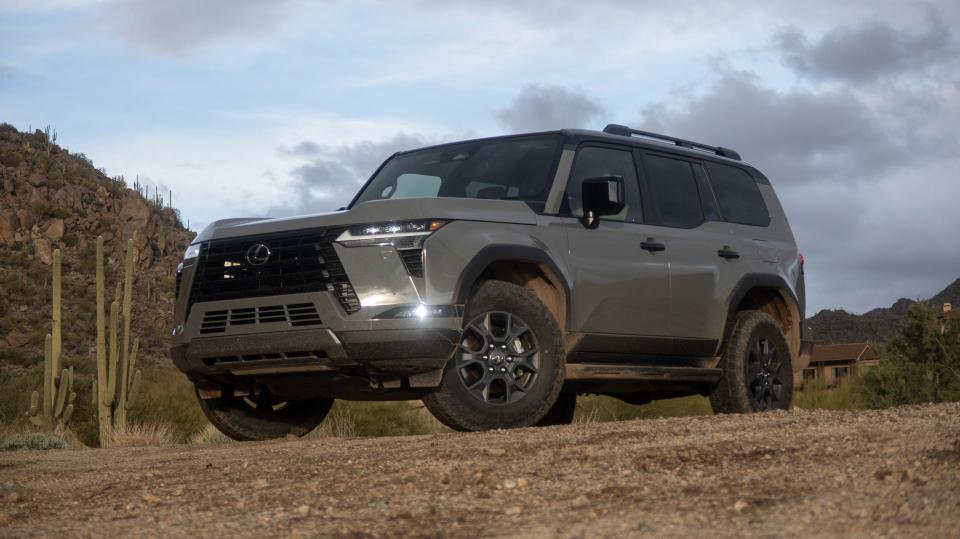2024 Lexus GX Tech Specs: Here’s Why It’s So Good

We got some neat diagrams and engineering insights on Toyota's off-road tech to share from the 2024 Lexus GX launch. The Kinetic Dynamic Suspension System (KDSS), which is now electronically controlled (E-KDSS), sounds like some Star Trek tech, but it's not that complex. In fact, the SUV is old school in a lot of ways.
I'll share and contextualize the most interesting excerpts from Lexus' briefing on the new GX for you here. I mentioned some of this stuff in our first-drive review of course, but I know my fellow 4x4 nerds will appreciate being able to paw through more details and specific performance claims.

Dimensions



The Overtrail and Overtrail+ are the 2024 Lexus GX's cool trim levels, adding some off-roady visual elements (fender flares, running boards, smaller wheels with bigger tires), a locking differential for very slippery conditions, and special traction control modes for different types of terrain. Those are going to tweak throttle and steering response too, to theoretically make your life easier when traction is bad.
You don't need that fancy stuff to drive off-road. High-quality all-terrain tires are the only thing I'd say "don't leave the road without." But like anything else, better tools tend to make a smoother experience.
As you can see, the Overtrail has a little extra ground clearance thanks to its taller tires. But all new GX models are supposedly able to drive in water that goes pretty much over the tires. I'd still advise a lot of caution with water fording though, real-world conditions can worsen quickly in flowing water.
Drive Modes



Like any other tool, it pays to get acquainted with the way a vehicle behaves in its various traction-management modes before you need them. But a multi-mode traction control system like Lexus' can take a bit of the work and thinking out of specific driving conditions.
In short, the MTS system sets you up for success—allowing more or less wheel slip, enhancing or decreasing steering sensitivity, and making other preemptive adjustments based on how the computer thinks it can best compensate for conditions.
Nothing can make up for actually knowing how to drive, but this system can be a boon even if you know what you're doing.
Underpinnings and Armor

A heavy-duty frame is at the core of every super-rugged off-road vehicle. You want a robust foundation to build around if you're going to be dealing with rough forces and a lot of weight.
The GX Overtrail has two main skidplates, a wide one below the engine and a long one protecting the fuel tank. But even the frame cross members are effectively pieces of armoring—look at that monolithic chunk of steel below the transmission. Heck, even the lower control arms look as resilient as elephant feet.



Electronics and Interface


I spent a lot of time talking about the GX's excellent ergonomics and the incredible quickness of its low-range engagement in my first drive review so I won't get deep into it again. But these images should give you even more insight as to what the vehicle's off-road-related controls look like from the driver's perspective.
Suspension



Many trucks, even some newish off-roady ones, use primitive leaf springs to bear the vehicle's weight. Those are efficient tools for dealing with large payloads, but they're not the best for responsiveness or higher-speed off-road performance. The GX's suspension is sweeter because, essentially, there are more joints to manage motion more effectively.
You don't see suspension setups like this on trucks all that often because it's tough to build something in this style that's also strong enough for off-road use.
Powertrain




Turbo V6s have replaced big V8s in a lot of performance vehicles, both on-road and off. The zero to 60 mph claim on the GX is pretty snappy (under seven seconds) and I found power pretty abundant once you have some momentum. I don't have any real complaints about the 10-speed automatic after my one-day drive.
As discussed in our review: I reckon drivers will benefit most from forced induction in this application when it's time to hit the ski slopes or climb a mountain. A turbocharged engine has a much easier time making power at high elevations when air density drops than a non-turbo one.
KDSS Versus E-KDSS
KDSS has been on Lexus GX models in America for about 20 years already, it was introduced on the first-gen GX around 2004. The idea behind it is that you put two big bars under the truck, one front and one back, connecting the left and right wheels. That's common in all kinds of vehicles; these are known as sway bars or anti-roll bars. They're like giant springs—when the car leans to the right as you turn left, the bar absorbs some force and re-distributes it back to the tire on the inside of the turn. What makes it KDSS is adjustability—the system can essentially increase and decrease the tension on those bars depending on driving conditions.
Science and math are required to figure out the optimal size and heft of such a bar on a given vehicle. As you could probably guess, you might want a stiff bar on a sports car to minimize body roll, but a softer bar on a truck where the wheels need to be able to absorb bumps and axle twists over rough terrain. Some off-roaders even have full a sway-bar disconnect function for maximum freedom in flexing.



A hallmark of the KDSS setup is that it puts a damper, essentially a mini shock absorber, at each corner of the sway bar itself. With this, it's theoretically able to change the stiffness of the bar rapidly. So when you're on pavement, it can be nice and firm for handling responsiveness, but then if you veer off onto a dirt road, it should be able to adapt instantly and give you the wheel travel or slack you might need to be comfortable on the rough stuff.
Sway bar stiffness is not the only factor dictating ride comfort and performance, but this is what Toyota's KDSS revolves around. As for the difference between the KDSS which's been out for decades and E-KDSS which is new in the last few years, the main thing is the isolation of individual wheels, as Lexus GX Chief Engineer Koji Tsukasaki explained to me through an interpreter.
"One of the challenges of having the current hydraulic system (on the outgoing GX) is the fact that the front and the rear are mechanically linked," the Lexus crew said. "If some external force hits one of the wheels in the back, it (can) inadvertently affect one in the front." The electronic system separates each corner's control system. The new system also allows for a linear control of coupling and decoupling of the stabilizer through the ECU, factoring in steering angle, vehicle speed, and lateral gs. That allows for more precise control. "For off-road applications, we can decouple the stabilizer to add extra articulation for the wheels. For on-road applications, it stays connected, so we get better handling."
In both older KDSS setups and the new E-KDSS, the dampers on the sway bar are filled with hydraulic fluid. But in the previous version, that fluid would be managed as one whole system across the car. With the current version, each damper is isolated and controlled individually. The advantages should include greater flexibility and more adaptive performance.
Unfortunately, a few hours with the system on side streets and dirt roads wasn't enough to speak deeply on the practical merits of this system. The Lexus GX felt good off-road, and good-but-not-great on-road, especially in sharp turns and panic maneuvers.
We'll have to spend more time with it to make a definitive ruling on the performance of E-KDSS, but the GX is a heck of a truck. I'd love the chance to put more miles on one to get a better sense of all its systems and overland capabilities.


 Yahoo Autos
Yahoo Autos 